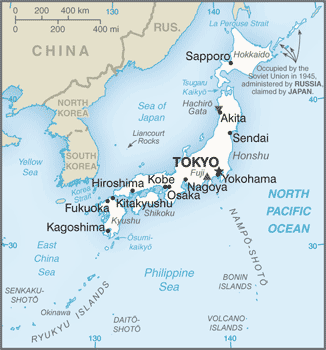 Well, this is really cute. With refreshing honesty, Fortune magazine on Sept. 14 issued a list of the "Fortune 5"—the biggest organized crime groups in the world, ranked by their annual revenue estimates. No sources are given, but the Fortune editors presumably relied on international law enforcement intelligence. The results are slightly surprising for those of us who grew up in the era of the Sicilian Mafia and Medellín Cartel. Brave new crime machines have long since eclipsed these entities from the global stage, and far outstripped their earnings from human trafficking, extortion, credit card fraud, prostitution and (above all) drug smuggling. In the number one slot, by a mile, is Yamaguchi Gumi, a wing of Japan's Yakuza, with revenue estimated at $80 billion. A distant second is Russian mafia group Solntsevskaya Bratva, with revenue at $8.5 billion. Three and four are two Italian outfits that have long superceded Sicily's Cosa Nostra: the Camorra, based in Naples, with revenues of $4.9 billion; and the 'Ndrangheta, based in Calabria, with revenues of $4.5 billion. Number five is Mexico's Sinaloa Cartel, with revenues of $3 billion.
Well, this is really cute. With refreshing honesty, Fortune magazine on Sept. 14 issued a list of the "Fortune 5"—the biggest organized crime groups in the world, ranked by their annual revenue estimates. No sources are given, but the Fortune editors presumably relied on international law enforcement intelligence. The results are slightly surprising for those of us who grew up in the era of the Sicilian Mafia and Medellín Cartel. Brave new crime machines have long since eclipsed these entities from the global stage, and far outstripped their earnings from human trafficking, extortion, credit card fraud, prostitution and (above all) drug smuggling. In the number one slot, by a mile, is Yamaguchi Gumi, a wing of Japan's Yakuza, with revenue estimated at $80 billion. A distant second is Russian mafia group Solntsevskaya Bratva, with revenue at $8.5 billion. Three and four are two Italian outfits that have long superceded Sicily's Cosa Nostra: the Camorra, based in Naples, with revenues of $4.9 billion; and the 'Ndrangheta, based in Calabria, with revenues of $4.5 billion. Number five is Mexico's Sinaloa Cartel, with revenues of $3 billion.
 At the annual Vienna meeting of the Commission on Narcotic Drugs, the governing body of the UN Office on Drugs & Crime (UNODC) voted Dec. 2 to strike cannabis from Schedule IV of the 1961 Single Convention on Narcotic Drugs, the global treaty regulating drug control policy.
At the annual Vienna meeting of the Commission on Narcotic Drugs, the governing body of the UN Office on Drugs & Crime (UNODC) voted Dec. 2 to strike cannabis from Schedule IV of the 1961 Single Convention on Narcotic Drugs, the global treaty regulating drug control policy.
 A new report by the British think-tank Prohibition Partners foresees a $5.8 billion cannabis market in Asia by 2024—if the tentative seeds of liberalization now witnessed across the continent in fact bear fruit.
A new report by the British think-tank Prohibition Partners foresees a $5.8 billion cannabis market in Asia by 2024—if the tentative seeds of liberalization now witnessed across the continent in fact bear fruit. While Canada's move to officially legalize cannabis has been hailed as courageous and historic by advocates around the world, some of the planet's most intolerant governments are reacting with dismay—even threatening to have their own citizens arrested if they indulge in legal marijuana on Canadian sovereign territory.
While Canada's move to officially legalize cannabis has been hailed as courageous and historic by advocates around the world, some of the planet's most intolerant governments are reacting with dismay—even threatening to have their own citizens arrested if they indulge in legal marijuana on Canadian sovereign territory. Cannabis is completely verboten n Japan—rare, expensive and very illegal. First Lady Akie Abe broke taboo by advocating a medical marijuana program from the country—but she's now embroiled in scandal, nipping the proposal in the proverbial bud. Yet more grassroots advocates have also emerged. One local historian in agricultural Tochigi Prefecture has opened a "cannabis museum," documenting millennia of use of the plant for medicine, sacrament and fiber in the archipelago.
Cannabis is completely verboten n Japan—rare, expensive and very illegal. First Lady Akie Abe broke taboo by advocating a medical marijuana program from the country—but she's now embroiled in scandal, nipping the proposal in the proverbial bud. Yet more grassroots advocates have also emerged. One local historian in agricultural Tochigi Prefecture has opened a "cannabis museum," documenting millennia of use of the plant for medicine, sacrament and fiber in the archipelago. The Japanese Buddhist community
The Japanese Buddhist community  Well, this is really cute. With refreshing honesty,
Well, this is really cute. With refreshing honesty, 





Recent comments
2 days 2 hours ago
4 weeks 2 days ago
8 weeks 19 hours ago
12 weeks 1 day ago
12 weeks 6 days ago
22 weeks 6 days ago
26 weeks 6 days ago
28 weeks 5 hours ago
28 weeks 8 hours ago
49 weeks 20 hours ago